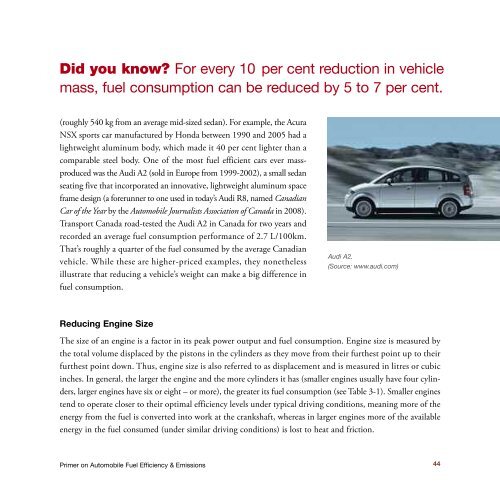Primer on Automobile Fuel Efficiency and Emissions - Pollution Probe
Primer on Automobile Fuel Efficiency and Emissions - Pollution Probe
Primer on Automobile Fuel Efficiency and Emissions - Pollution Probe
Create successful ePaper yourself
Turn your PDF publications into a flip-book with our unique Google optimized e-Paper software.
Did you know? For every 10 per cent reducti<strong>on</strong> in vehicle<br />
mass, fuel c<strong>on</strong>sumpti<strong>on</strong> can be reduced by 5 to 7 per cent.<br />
(roughly 540 kg from an average mid-sized sedan). For example, the Acura<br />
NSX sports car manufactured by H<strong>on</strong>da between 1990 <strong>and</strong> 2005 had a<br />
lightweight aluminum body, which made it 40 per cent lighter than a<br />
comparable steel body. One of the most fuel efficient cars ever massproduced<br />
was the Audi A2 (sold in Europe from 1999-2002), a small sedan<br />
seating five that incorporated an innovative, lightweight aluminum space<br />
frame design (a forerunner to <strong>on</strong>e used in today’s Audi R8, named Canadian<br />
Car of the Year by the <strong>Automobile</strong> Journalists Associati<strong>on</strong> of Canada in 2008).<br />
Transport Canada road-tested the Audi A2 in Canada for two years <strong>and</strong><br />
recorded an average fuel c<strong>on</strong>sumpti<strong>on</strong> performance of 2.7 L/100km.<br />
That’s roughly a quarter of the fuel c<strong>on</strong>sumed by the average Canadian<br />
vehicle. While these are higher-priced examples, they n<strong>on</strong>etheless<br />
illustrate that reducing a vehicle’s weight can make a big difference in<br />
fuel c<strong>on</strong>sumpti<strong>on</strong>.<br />
Audi A2.<br />
(Source: www.audi.com)<br />
Reducing Engine Size<br />
The size of an engine is a factor in its peak power output <strong>and</strong> fuel c<strong>on</strong>sumpti<strong>on</strong>. Engine size is measured by<br />
the total volume displaced by the pist<strong>on</strong>s in the cylinders as they move from their furthest point up to their<br />
furthest point down. Thus, engine size is also referred to as displacement <strong>and</strong> is measured in litres or cubic<br />
inches. In general, the larger the engine <strong>and</strong> the more cylinders it has (smaller engines usually have four cylinders,<br />
larger engines have six or eight – or more), the greater its fuel c<strong>on</strong>sumpti<strong>on</strong> (see Table 3-1). Smaller engines<br />
tend to operate closer to their optimal efficiency levels under typical driving c<strong>on</strong>diti<strong>on</strong>s, meaning more of the<br />
energy from the fuel is c<strong>on</strong>verted into work at the crankshaft, whereas in larger engines more of the available<br />
energy in the fuel c<strong>on</strong>sumed (under similar driving c<strong>on</strong>diti<strong>on</strong>s) is lost to heat <strong>and</strong> fricti<strong>on</strong>.<br />
<str<strong>on</strong>g>Primer</str<strong>on</strong>g> <strong>on</strong> <strong>Automobile</strong> <strong>Fuel</strong> <strong>Efficiency</strong> & Emissi<strong>on</strong>s<br />
44
















